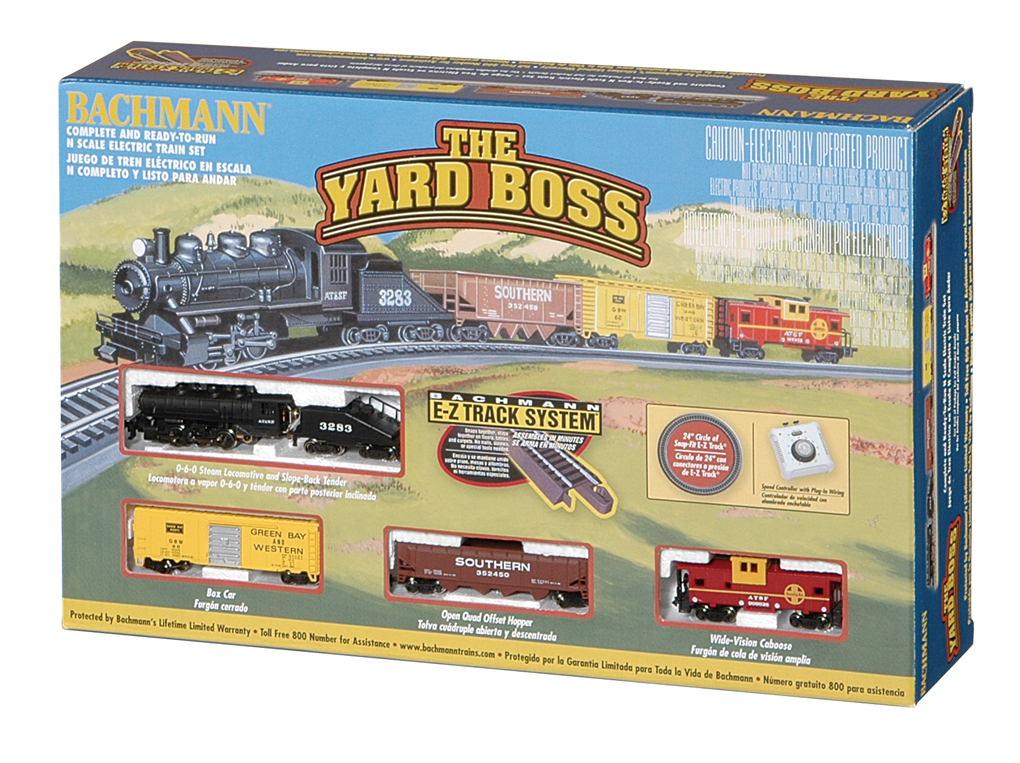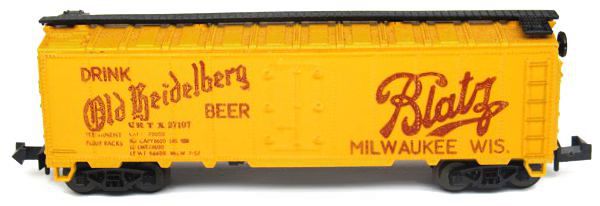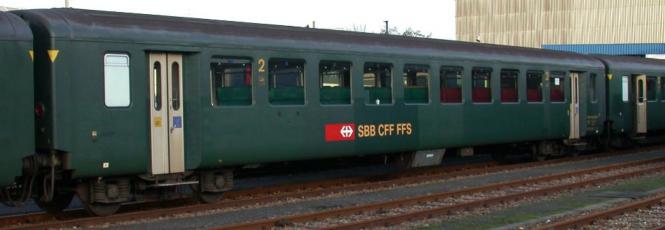Lima - 308 - Passenger Car, SBB-CFF, EW I / VU I - SBB CFF FFS - A 2501
| Stock Number | 308 |
| Secondary Stock Number | 320308 |
| Brand | Lima |
| Manufacturer | Lima |
| Body Style | Lima Passenger Car SBB EW I |
| Prototype Vehicle | Passenger Car, SBB-CFF, EW I / VU I (Details) |
| Road or Company Name | SBB CFF FFS (Details) |
| Reporting Marks | SBB CFF |
| Road or Reporting Number | A 2501 |
| Paint Color(s) | Green w. Silver doors and roof |
| Print Color(s) | Yellow |
| Coupler Type | Rapido Hook |
| Coupler Mount | Truck-Mount |
| Wheel Type | Nickel-Silver Plated Metal |
| Wheel Profile | Standard |
| DCC Readiness | No |
| Release Date | 1968-01-01 |
| Item Category | Passenger Cars |
| Model Type | European |
| Model Subtype | SBB-CFF |
| Model Variety | EW I / VU I 1st class coach |
| Prototype Region | Europe |
| Prototype Era | EU Epoch III (1945 - 1970) |
| Years Produced | 1956-1967 |
| Scale | 1/160 |
Model Information:
Introduced in 1968, this body style was available up until the early 1980's.
With a length of 138mm, this car is shorter than the prototype SBB-CFF EW I; it should be 148 mm at N scale (1/160) to be prototypically correct.
With a length of 138mm, this car is shorter than the prototype SBB-CFF EW I; it should be 148 mm at N scale (1/160) to be prototypically correct.
Prototype History:
The Swiss Unified Cars I (German: Einheitswagen EW, French: Voitures Unifiées VU) are the successors of the light steel cars and were built between 1956 and 1967.
They were originally painted in SBB green and had a weight of 28 to 32 tons, a length of 23.7 m and a permissible top speed of 140 km/h.
A total of 1249 have been built, out of which:
- 1st class lounge (2)
- 1st class, type A (180)
- 1st/2nd class, type AB (39)
- 2nd class, type B (1028)
- Dining cars, type WR (11)
- 2nd class/Baggage Cab, type BDt (27)
- 1st/2nd class Cab, type ABt (22)
- Baggage / Post Office, type DZt (6)
They were originally painted in SBB green and had a weight of 28 to 32 tons, a length of 23.7 m and a permissible top speed of 140 km/h.
A total of 1249 have been built, out of which:
- 1st class lounge (2)
- 1st class, type A (180)
- 1st/2nd class, type AB (39)
- 2nd class, type B (1028)
- Dining cars, type WR (11)
- 2nd class/Baggage Cab, type BDt (27)
- 1st/2nd class Cab, type ABt (22)
- Baggage / Post Office, type DZt (6)
Road Name History:
Swiss Federal Railways (German: Schweizerische Bundesbahnen (SBB), French: Chemins de fer fédéraux suisses (CFF), Italian: Ferrovie federali svizzere (FFS)) is the national railway company of Switzerland. It is usually referred to by the initials of its German, French and Italian names, either concatenated as SBB CFF FFS, or used separately.
The company is headquartered in Bern.
Read more on Wikipedia.
The company is headquartered in Bern.
Read more on Wikipedia.
Brand/Importer Information:
Lima N scale European models were numbered with 3 digits until 1978. They were renumbered after 1978 by adding "320" before the previous number. e.g. "306" became "320306".
Manufacturer Information:
 Lima S.p.A (Lima Models) was a brand of railway models made in Vicenza, Italy, for almost 50 years, from the early 1950s until the company ceased trading in 2004. Lima was a popular, affordable brand of 00 gauge and N gauge model railway material in the UK, more detailed H0 and N gauge models in France, Germany, Italy, Switzerland, and the United States as well as South Africa, Scandinavia and Australia. Lima also produced a small range of 0 gauge models. Lima partnered with various distributors and manufacturers, selling under brands such as A.H.M., Model Power, Minitrain and PMI (Precision Models of Italy). Market pressures from superior Far Eastern produce in the mid-1990s led to Lima merging with Rivarossi, Arnold, and Jouef. Ultimately, these consolidations failed and operations ceased in 2004.
Lima S.p.A (Lima Models) was a brand of railway models made in Vicenza, Italy, for almost 50 years, from the early 1950s until the company ceased trading in 2004. Lima was a popular, affordable brand of 00 gauge and N gauge model railway material in the UK, more detailed H0 and N gauge models in France, Germany, Italy, Switzerland, and the United States as well as South Africa, Scandinavia and Australia. Lima also produced a small range of 0 gauge models. Lima partnered with various distributors and manufacturers, selling under brands such as A.H.M., Model Power, Minitrain and PMI (Precision Models of Italy). Market pressures from superior Far Eastern produce in the mid-1990s led to Lima merging with Rivarossi, Arnold, and Jouef. Ultimately, these consolidations failed and operations ceased in 2004.
Hornby Railways offered €8 million to acquire Lima's assets (including tooling, inventory, and the various brand names) in March of the same year, the Italian bankruptcy court of Brescia (town near Milan, last headquarters of Lima) approving the offer later that year. In December 2004, Hornby Railways formally announced the acquisition along with the Rivarossi (H0 North American and Italian prototypes), Arnold (N scale European prototypes), Jouef (H0 scale French prototypes), and Pocher (die-cast metal automobile kits) ranges. As of mid-2006, a range of these products has been made available under the Hornby International brand, refitted with NEM couplings and sprung buffers and sockets for DCC (Digital Command Control) decoders.
From Wikipedia

Hornby Railways offered €8 million to acquire Lima's assets (including tooling, inventory, and the various brand names) in March of the same year, the Italian bankruptcy court of Brescia (town near Milan, last headquarters of Lima) approving the offer later that year. In December 2004, Hornby Railways formally announced the acquisition along with the Rivarossi (H0 North American and Italian prototypes), Arnold (N scale European prototypes), Jouef (H0 scale French prototypes), and Pocher (die-cast metal automobile kits) ranges. As of mid-2006, a range of these products has been made available under the Hornby International brand, refitted with NEM couplings and sprung buffers and sockets for DCC (Digital Command Control) decoders.
From Wikipedia
Item created by: Alain LM
on 2020-02-10 02:16:53
Last edited by: Lethe on 2020-05-07 00:00:00
If you see errors or missing data in this entry, please feel free to log in and edit it. Anyone with a Gmail account can log in instantly.
Last edited by: Lethe on 2020-05-07 00:00:00
If you see errors or missing data in this entry, please feel free to log in and edit it. Anyone with a Gmail account can log in instantly.











